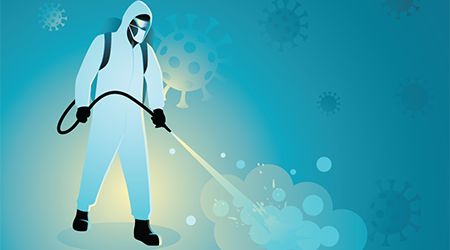
From misting to spraying to fogging, building service contractors (BSCs) have a wide range of tools at their disposal for delivering cleaners, sanitizers and disinfectants. But choosing the right delivery mechanism can be daunting. Dispensers that emit particles into the air can have a negative impact on indoor air quality, as well as dwell time compliance.
Fortunately, dispensing methods are similar regardless of the task at hand. When in doubt, BSCs should review the differences and primary functions of cleaners, disinfectants and sanitizers, which will help them select the right application system.
"Cleaners remove dirt, soil and pathogens from the surface, but they do not kill," says Heidi Wilcox, owner and founder of Wilcox EVS, Haverhill, Massachusetts. "They are the first and most important step in the disinfection process. Sanitizers kill to a log 3 reduction in pathogens on the surface. These products generally have a lower chemical concentration and shorter dwell times. Disinfectants can have the same chemistry as sanitizers, but they have a higher chemical concentration and kill to a log 5 reduction or an 'almost total kill.'"
Industry experts agree that understanding these differences is essential before choosing an application method.
Pulling The Trigger
Historically, trigger sprayers have been one of the most popular ways to apply cleaners, sanitizers and disinfectants. However, an increasing number of BSCs are moving away from this delivery method. For example, many hospitals are asking their janitors to abandon spray bottles altogether.
"Instead, hospitals are using flip tops on quart bottles to saturate rags and apply chemicals to the surface, or dipping the cloth in a bucket and then wringing it out and wiping the surface," says Bill Griffin, president of Cleaning Consultant Services Inc., Seattle.
The reason for this change is that overspray from trigger sprayers can cause particles to become airborne, thereby creating a potential health hazard for janitors and building occupants.
"Trigger sprayers are not a preferred method of dispensing products because of the possibility of atomizing chemicals and making them breathable particles," says Darrel Hicks, author of Infection Prevention For Dummies. "Also, when applying disinfectant using this method, the surface is often not saturated sufficiently, so there isn't enough contact time for the disinfectant to do its job."
Although trigger sprayers have adjustable nozzles, Hicks prefers to take the guesswork out of the disinfection process. He recommends flip-top bottles that emit a "fairly core stream," leaving the surface wetter for longer and allowing the user greater control over the amount of liquid being dispensed. These tops are best suited for cleaning and disinfecting horizontal surfaces, such as countertops and desks.
Pre-saturated wipes are also gaining popularity for disinfecting surfaces. While they eliminate the risk of breathing in aerosolized particles, a lack of training and the absence of standards could impact their efficacy.
"There are no standards regarding what type of material the wipes are made of, so some are better than others at picking up soil," says Hicks. "You also need to determine how wet the wipe is, because sometimes people leave the top open and the disinfectant evaporates. Training is important so that employees know how long to use a wipe before discarding it."
For larger surface areas, such as restrooms and in-suite shower stalls, handheld pump-up sprayers that deliver targeted streams of cleaners or disinfectants to surfaces are recommended. Low-pressure wands are also an effective option for cleaning and rinsing all areas of the restroom, including walls, floors, urinals and sinks.
Infection Prevention Dispensing Technologies

 Celebrating BSCAI's 60th Anniversary eBook
Celebrating BSCAI's 60th Anniversary eBook The Down and Dirty on Cleaning in Virus Season
The Down and Dirty on Cleaning in Virus Season How Surfactant Use is Expanding in Commercial Cleaning
How Surfactant Use is Expanding in Commercial Cleaning